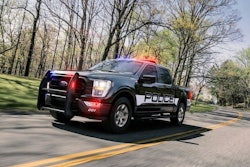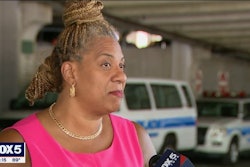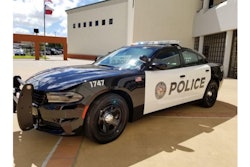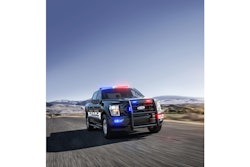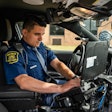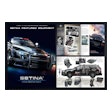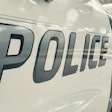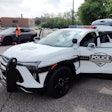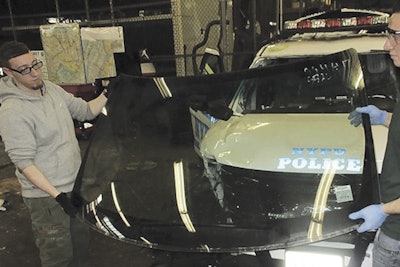 In the May 2020 riots more than 600 pieces of glass were smashed on NYPD vehicles, as more than 375 vehicles were damaged. Much of the replacement glass was salvaged from vehicles that the NYPD had removed from service because of wrecks.
In the May 2020 riots more than 600 pieces of glass were smashed on NYPD vehicles, as more than 375 vehicles were damaged. Much of the replacement glass was salvaged from vehicles that the NYPD had removed from service because of wrecks.
For 26 years, Vartan Khachadurian, director of the Fleet Services Division for the NYPD, has witnessed his team work to improve the agency’s fleet operations and make them more efficient and economical. He has praised those he works with for their ingenuity and desire to discover how to do more with what they already have.
He says the department’s salvaging program has saved time and money, and he wants to share how it works with other agencies. He also takes great pride in the steps everyone at the NYPD’s Fleet Services Division takes to maintain a safe working environment.
Riot Damage
The NYPD’s fleet was hit heavily by the rioting and property destruction that followed the in-custody death of George Floyd.
Khachadurian says NYPD Fleet Services Deputy Director Richard Catalano had to deal with as many as 375 vehicles that were vandalized during the riots of May 2020. The riot damage included 600 pieces of glass smashed and in need of replacement.
“Thankfully he’s a good, strong leader and was able to garner everybody’s cooperation. No vendor is going to be able to keep up with that amount of shattered glass, especially within a reasonable amount of time,” Khachadurian says.
So, the department made use of its salvage program. The team doesn’t want any still-usable parts on older vehicles or equipment to go to waste. For instance, if a car gets into a front-end collision, technicians will take everything off the back and inside, from seats to prisoner partitions to sirens, and reuse it.
A trained team began removing glass out of already totaled vehicles to assist in the repair of the ones damaged during the riots. The NYPD has a few mechanics that know how to do glass work because they worked with glass vendors before their employment with the police. The department was able to do about 90% of the glass work in-house while also receiving a bit of help from vendors.
Salvaging Economics
Looking for new ways to save money due to a drop in funding, NYPD Fleet Services Deputy Director James Korotki saw an opportunity to save some money on emergency response equipment. Reusing salvaged equipment enabled the department to purchase more vehicles.
The team removed lightbars and other response equipment, as well as prisoner partitions, from salvaged vehicles. This salvaging strategy saves the department $5,000 on every vehicle it purchases. That’s saying something for a department that purchases anywhere from 750 to 1,250 vehicles annually, depending on the year.
Khachadurian says that when the department has vendors do vehicle upfits, they can be a bit skeptical when asked to make use of salvaged parts because it takes away from their assembly-line mentality.
“We made kits for all these parts. Prior to making the kits, we developed a test bench, because we didn’t want to hear the upfitter say ‘you gave me a bad bulb’ or ‘the siren didn’t work.’ We make sure to send a few extras along as well just in case,” he explains.
NYPD Fleet Services Deputy Director Michael Gorgia, who’s responsible for the OEM parts the department purchases, built a salvage cage where parts like fenders, bumpers, hoods, glass, and doors are kept ready and waiting to be reused. If a vehicle comes back with a busted door, for instance, the department saves time and money because it has an already-decaled door waiting to be reused.
In fiscal year 2020, this salvage program saved the department $5.5 million.
Reducing Damage
Khachadurian recalls a time when he was walking through one of the NYPD’s body shops and an autobody worker pulled him over to a car to discuss push bumper damage.
At the time the push bumpers used by the NYPD would extend off a vehicle about seven inches. In an intersection, that’s just enough for another car to grab on with its bumper. Because the push bumper is so secured to the bumper of the police vehicle, that kind of accident bends both of the chassis rails. Many vehicles involved in these collisions would be damaged beyond repair and had to be totaled and salvaged.
A regular bumper would only produce a glancing blow because it wouldn’t stick out as far. Therefore, the department started buying vehicles without the push bumpers, which saved about $250 a car.
“The amount of time and bodywork it saves is well beyond that, and it prevented a lot of people from getting hurt. Listening to those who work closely with the cars, it made all the sense in the world; it’s so important to just listen,” he said.
Data Making a Difference
The NYPD’s data unit, led by Fleet Services Deputy Director Hassan Eldaly, has played a huge role in determining how to improve maintenance intervals. The department has been able to extend planned maintenance intervals from 4,000 to 6,000 miles on electric and hybrid vehicles based on the data from reports on actual mileage the data unit gets through a fuel management system. Other reports monitor uptime using a weighted system to prioritize workflow.
“We’ll give this report to a shop, and it lets them know what vehicles should be serviced and when. It’s basically a menu for success,” Khachadurian said.
Taking Suggestions
The fleet department has another unit dedicated specifically to safety and training, led by District Supervisor James D’Ambrosio. It hosts a monthly focus group that speaks about vehicle repair and conditions in the shop. Khachadurian says someone who is a part of the executive team will always show their face in that meeting to ensure those who speak and ask for something know they are being heard.
“It doesn’t just fall on deaf ears; we take care of it. If they give me a problem, it’s my obligation to come up with a solution, and that’s what we do. You don’t get buy-in without showing you’re on their side too,” Khachadurian says.
This goes for procurement as well. Whenever a new vehicle is being spec’ed, Khachadurian will invite end-users and bosses to sit together and discuss what works for them. From there, they will figure out how to tailor a vehicle around their needs. The spec will get double-checked by Khachadurian, then go directly to Fleet Services Deputy Commissioner Robert Martinez. The team will look at all potential changes and discuss options before it’s finalized.
“We all have a role in making sure this works. Deputy Commissioner Martinez ingrained in us that every new vehicle spec should be written better than the last,” he says.
3D Printing and the Future
The current project NYPD is exploring is 3D printing. While the purchase of a 3D printer has yet to receive final approval, the plan is to create parts that will enable a more precise fit.
“It might help you aim an LED light a little better on a curved body panel, for example. It may sound like a silly thing, but safety is number one. Officers are killed in traffic incidents too often. I want to make sure everyone is seen,” Khachadurian explains.
Lexi Tucker is senior editor of Government Fleet, a sister publication of POLICE.




